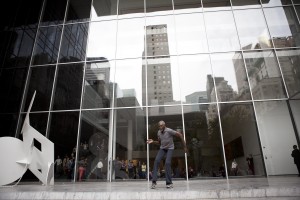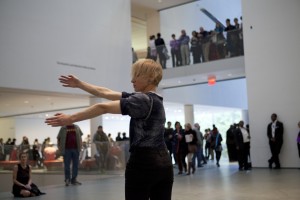French choreographer Boris Charmatz is presenting three different programs this fall at the Museum of Modern Art in New York City under the umbrella title: Three Collective Gestures (October 18-November 3). In many ways, he is taking on the whole contemporary issue of the relation of dance to the museum. In his first offering, 20 Dancers for the XX Century, Charmatz has curated twenty dancers, each one presenting a solo or solos by twentieth-century choreographers. Some of the works are well known and some are relatively unknown. The solos were announced for between noon and 5pm, during which time one could find them in numerous locations in the museum, popping up unexpectedly and serially throughout MoMA’s five floors and garden. This format has its charms: there are architectural cut-out effects in MoMA thanks to which one suddenly spies a space two floors down, particularly interesting to look at when the cut-out frames a dancing body. But, then, dance constitutes a sort of light diversion in the process of navigating the museum, which, in the case of MoMA, is a bustling public space. The format also proved to be chaotic and frustrating of any attempt to learn what one was seeing.

And, the conditions of performance in this setting have to be challenging for the dancers: the floors are hard and in many cases the public streams past the dancer to a nearby staircase. The Atrium, on the other hand, is sufficiently large to constitute an area the dancer can exploit to his or her advantage, but the problem of the unforgiving floor remains here as well. I was most moved, however, by seeing Gus Solomons performing his solo in homage to John Cage in the garden next to a Giacometti sculpture. It made me think that the dialogue between dance and visual art was an important aspect of twentieth-century dance. (A recent exhibition at the Centre Pompidou in Paris pointed to this connection). The historical connection of dance to the visual was also brought home by MoMA’s recent show “The Invention of Abstraction” in which dance – albeit not live dance – was prominently featured.
What this production highlighted is what Ralph Lemon — in discussion with Simone Forti, and Boris Charmatz moderated by Associate Curator (Department of Media and Performance Art) Ana Janevski, (October 25, 2013) – referred to as the dancer in the museum as visitor: “The dancers were visitors,” Lemon said of his own experience of performing in the Atrium, “visitors with agency, but visitors”. “Dance,” continued Lemon, “will always be on the outside. It doesn’t really belong there.”
Here, it should be mentioned that Boris Charmatz’s base in Rennes, France, is called “Musée de la Danse” (Dance Museum). So, there is already with Charmatz a conception of museality that has been transmuted into the reality of dancing. In the discussion Charmatz characterized his appearances at the Museum of Modern Art as an opportunity to place one museum within the other. The idea with respect to 20 Dancers for the XX Century is that dancers enact fleeting interventions in which the collections of MoMA are rivaled by the idea of a museum of dance, one in which the dancer him or herself is not only the “work of art”, but also the explicatory label and/or catalogue: in short, in which the dancer is at once artwork, pop-up materialization of choreography, and a living archive able to inform about it. This all happens within a museum that is operating in an entirely different way. The museum within the museum is not an easy fit. The museum of dance that sits uneasily within the halls of the MoMA is multiple: each dancer him or herself, according to Charmatz, constitutes an autonomous museum. As the program puts it:
Each performer presents his or her own museum, where the body is the ultimate space for the dance museum. Hence there is neither a stage nor a demarcation of performance space.
This sounds better on paper than it looks in practice. But, the idea is that the dance museum is virtual. Charmatz states: “the force of a museum of dance lies especially in the fact that it does not yet exist.” If dance appears as a virtual museum within a non-virtual museum then the transitoriness of dance is being emphatically emphasized. In that same manifesto, Charmatz wrote: “We are at a time in history where a museum in no way excludes precarious movements or nomadic, ephemeral, instantaneous movements.” His is a museum within a museum in the sense of a body in a building, a living and breathing human being among artifacts, energy amidst what could be experienced as the inertia of a material culture of the object. What does it mean to say this moment in history does not exclude precarious movements in the museum? Installation and video have been part of museum exhibition and collection for some time now. The dancer’s body may have an archival dimension – but is this enough since a museum is so much more than an archive and in many senses not an archive – but how does the dancer generate on that basis a space of exhibition adequate to their expressive capacity? This is one of the questions that this event raised but did not answer. But, perhaps to raise it is enough.
I still wonder about how the idea of a museum of dance such as Charmatz conceives it can be manifested in the context of an institution such as MoMA where the artwork has been so carefully and expertly staged in galleries. How can dance as visitor compete with visual art in its home if dance does not occupy a space adequate for its own contemplation? The museum within the museum inevitably suggests a comparison – an agon – in the encounter of two forms of art, the visual and the performative.

At times I had the sensation the dancer was challenging the museum as a static space by the intrepid intervention of the moving body – daring, beautiful, theatrical, dynamic, funny — at the museum’s margins and in its very transitional public spaces between galleries or at the base of stairways and escalators. The dancers often took on their marginal status and played it to the hilt. But, this challenge is not of the essence of the desired encounter: the sensation of inferiority at being an artwork as visitor — a turning inside out of the relation between living beings and exhibited objects – leads to certain hubris whereby the living, breathing, animate dancer implicitly expresses a superiority to art that does not move but hangs in stasis while, nonetheless, that “static” art maintains its monetary value and cultural capital. Museums producing dance should take on the responsibility to produce dance visually with the same care they bestow upon visual art. The playing field might thereby be somewhat leveled.
Even though the Musée de la danse in Rennes is not a conventional museum — it has no gallery space — but a place for dancer training and choreographic experimentation it is related to the museum inasmuch as it is also a site for learning and invention. This speaks to a concept of the museum as a space of learning and invention. If Charmatz has chosen to place the word museum next to the word dance it is perhaps because the idea of the self-educating dancer is one that encompasses the dancer’s appropriation of dance history. That history in the twentieth century is one that is deeply engaged with visual art. Thus, for several possible reasons the museum for Charmatz is the appropriate figure of, or term for, such a project. As Yvonne Rainer remarked at the discussion a museum is a conservative institution. However, when the dancer appropriates his or her own history, reserving the right to express, formalize, and articulate it in/as a performance then I believe one may refer to a museum as a performative idea.
All in all, there is – and has been for some time — a tendency in contemporary French dance to put more power in the hands – and bodies – of dancers by wresting control of the pedagogical and historiographic project of institutionalized dance training. A sense of the contemporary dancer as autodidact emerges from recent debates in the French world of contemporary dance. Charmatz’s idea of the museum within the body and the body as a performative mini-museum derives to some degree from this autodidactic project, one that he has described and theorized in the context of an earlier initiative – Bocal (Jar) – in his book Je suis une école. Expérimentation, Art, Pédagogie [I am a school: Experimentation, Art, Pedagogy] (Paris: Les Prairies Ordinaires, 2009). French institutional power over the training of dancers is at issue in the very idea of the dance museum.
The transformative potential of the museum for dance in Charmatz’s view, as I understand it, resides paradoxically in its very educational and specifically autodidactic potential – hence the audience is also meant to learn — although that potential has been transferred from educational institutions such as conservatories or museums to the dancer him or herself.